|
[Front Page] [Features] [Departments] [Society Home] [Subscribe]

Mallows are Frog Favourites
Colleen Keena
The following has been adapted from an article in the series "Marvellous Mallows", published by Hibiscus International. The series is compiled by Colleen Keena from Queensland, Australia, Kristin Yanker-Hansen from California, USA and Marcos Capelini from Sao Paulo, Brazil. Mallows refers to members of the Malvaceae Family.
Note: The "W" references in the text refer to web material (W) listed under References.
Introduction to a frog-friendly hibiscus garden
Why would those who grow members of the Malvaceae family, such as hibiscus and hibiscus family plants, want to consider attracting frogs to their garden or even to the shade-house containing hibiscus plants?
The answer is simple: frogs are responsible for naturally controlling pests of Hibiscus, especially those pests that remain in and close to the surface of the soil as part of their life cycle, for example, the larvae of the Hibiscus Beetle and the Scarab Beetle (W1).
 |
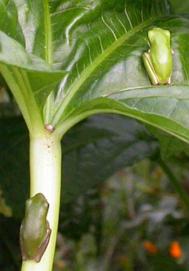 |
Left: Frog sitting beside a Hibiscus Beetle on a bloom of Hibiscus heterophyllus
Right: These frogs are near scale on Abelmoschus manihot
Photos: Geoff Keena |
Because one of the authors lives in south-east Queensland, the focus of this article will be on frogs that occur in the author's garden. The two frogs most often seen are the Eastern Sedge Frog, Litoria fallax (W2) and the Common Green Treefrog, Litoria caerulea (W3) and these will be the two species shown in the photos. The Eastern Sedge Frog is a small species, growing to about 30 mm. It is usually green in summer and may be brown in winter. The Common Green Treefrog is much larger, to about 100 mm or more in length. It too is usually green but can also be brown or blue or almost black.
As frogs eat insects, they account for millions of insects daily. They also eat other small invertebrates. It has been suggested that frogs play an important role in maintaining the balance of nature because of the millions of insects they consume (W4). The diet of seven Australian frog species, all Litoria, is documented as being primarily insects (W5). Because frogs eat a variety of insects, they can act as natural insect predators (W6).
 |
|
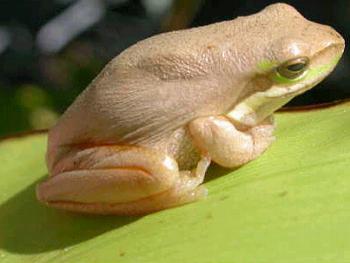 |
|
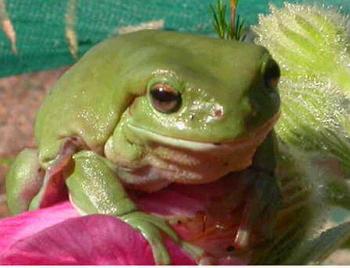 |
|
Top: Eastern Sedge Frogs on Hibiscus diversifolius
Centre: An Eastern Sedge Frog in winter
Bottom: Common Green Treefrog
Photos: Geoff Keena
|
|
While the adult frog feeds on insects and other invertebrates, such as earwigs, grasshoppers, crickets and they also eat spiders, most tadpoles are filter feeders and it has been shown that they can play a major role in regulating nutrients in a pond (W7).
Frogs have been described as indicator species and any decline in frog populations is a warning that environmental changes are taking place and that it is in our own interests to take heed (W4). Frogs are extremely sensitive to their surroundings, partly due to their skin not being waterproof. They do not actually drink water, rather they lie on a moist spot or puddle and absorb water through their permeable skin. They also absorb electrolytes and air as well as excrete waste through their skin. Any form of chemicals, detergents, oils, pesticides and herbicides can therefore be absorbed into their body and bloodstream, with the frog unaware that it may be having its last drink or giving its future offspring five legs (W8).Their eggs, which lack protective shells and are laid in water, are also vulnerable (W9). Frogs may eat poisoned insects with fatal consequences (W10).
So, frogs are important to a garden with hibiscus for the role they play in keeping pest populations, including pests specific to hibiscus, under control. However, the importance of frogs goes beyond their contribution to the good health of the environment and their beneficial impact on your garden. They play crucial roles in the ecosystem and the health of their populations is a good indicator of the health of the environment (W9).
Developing a frog-friendly hibiscus garden
There are four main things to ensure a frog-friendly garden. Frogs need moisture, shelter and food and a suitable place to breed (W6, W8, W10, W11).
Moisture and humidity
As their skin must never dry out, frogs require areas that are wet or moist, in addition to needing water for tadpole development. Frogs also need humidity. A well-vegetated garden including ground covers, understorey plants and small to large trees will decrease wind movement, thus increasing humidity.
- Keep the yard well watered
- A pond will also attract frogs
Hiding Places: shelter and protection
Frogs also require something to shelter beneath during the heat of the day and when it is windy to prevent desiccation. This can be supplied with vegetation, bark and leaf litter. The most sensible type of vegetation is the type that is native to the area. Shrubs and ground cover provide frogs with a comfortable resting place, hiding spots from predators and shelter from wind. Vegetation also attracts insects to your garden.
- Grow lots of plants of various heights in your garden
- Use a natural leafy mulch around garden beds and ponds
Food
Frogs eat a variety of insects including moths, mosquitoes and their larvae, cockroaches, snails and flies. Their prey must move and be of a suitable size for the frog to detect, catch and eat. Frogs love vegetable gardens and greenhouses. Tadpoles live on algae and micro-organisms and decaying plant matter in and around a pond will provide these essential nutrients. Use of insecticides will kill frog food and affect the health of frogs too.
- Attract insects by mulching garden beds, keeping a compost heap and having a wide variety of local native plant species
Suitable places to breed
| |
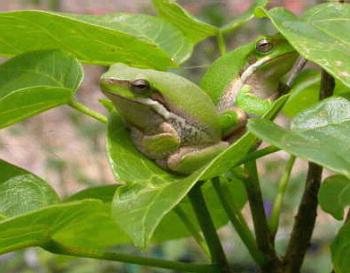 |
| |
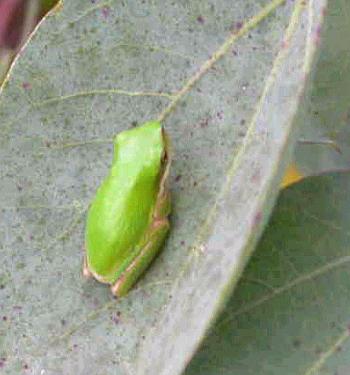 |
| |
Frogs making themselves at home on Sterculia quadrifida (top) and Gossypium sturtianum (bottom)
Photos: Geoff Keena |
The tadpole stage of the frog life cycle is dependent on water so building a pond is the best way to invite frogs to make your garden home. If you have a swimming pool, frogs may drown in it as they are attracted by the high humidity and the surrounding garden. To prevent drownings, a sloping float should be placed at the edge of the pool as frogs swim around the edge looking for a toehold to climb out.
- Ponds with shady coverings and emergent aquatic plants are good breeding places for frogs
It is best not to move frogs, even within suburbs. If the new area is not quite right, they will most likely die, migrate away or interfere with frogs that belong there. If you want frogs in your garden, provide the best conditions you can. If frogs live nearby, they will come to you (W11) but remember to be patient as frogs can take up to a couple of years to settle into your garden (W6, W9).
Hibiscus and hibiscus-like plants are frog-friendly plants
The photos all show how once frogs do take up residence in the garden, they are particularly attracted to hibiscus and hibiscus-like plants.
This is possibly because the large leaves on most hibiscus family plants provide shelter for the frogs. Species with large green leaves, eg. Abelmoschus manihot, Hibiscus diversifolius and Talipariti tiliaceum (formerly Hibiscus tiliaceus) often have a number of frogs sheltering under leaves whereas species with finer foliage such as Alyogyne hakeifolia attract frogs but usually only one frog can be seen. Frogs can even be found on the pungent foliage and stems of Gossypium sturtianum.
Although the one-acre garden where these images were taken has many local area plants, eg. wattles, bottlebrushes, gum trees, it is rare to see frogs on local species.
Experience has shown that the best chance of finding frogs is by making a check of the hibiscus and hibiscus-family plants, especially those with large leaves.
Summary
As well as helping to control insects of particular importance to those who grow Malvaceae, such as the Hibiscus Beetle, frogs add yet another dimension into the garden with their colours, sounds and activities (W8).
By caring for frogs and learning about their needs we improve not only the quality and persistence of their existence, but the quality of ours as well (W8).
References
W1. Identification of Insects, Pests and Diseases that effect Hibiscus rosa-sinensis Cultivars
W2. Queensland Museum: Eastern Sedgefrog
W3. Queensland Museum: Common Green Treefrog
W4. Frogs of the Australian National Botanic Gardens
W5. The Frogs of NSW Wetlands
W6. Queensland Government: Frogs
W7. Earthbeat: Frogs in Farm Dams
W8. Attracting Frogs to your Garden
W9. Attracting wildlife: frogs, toads & other creepy critters
W10. Making Your Garden Frog Friendly?
W11. Queensland Frog Society
For further information on Hibiscus and Hibiscus-like plants see Colleen's previous articles in Australian Plants online:

[Front Page] [Features] [Departments] [Society Home] [Subscribe]
Australian Plants online - June 2004
Association of Societies for Growing Australian Plants
|